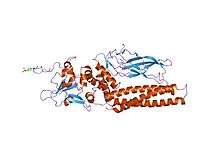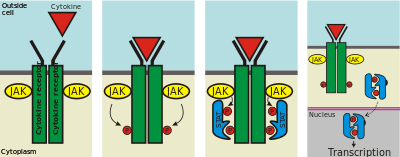STAT protein

Domains and covalent modification sites of STAT proteins.
Members of the signal transducer and activator of transcription (STAT) protein family are intracellular transcription factors that mediate many aspects of cellular immunity, proliferation, apoptosis and differentiation. They are primarily activated by membrane receptor-associated Janus kinases (JAK). Dysregulation of this pathway is frequently observed in primary tumors and leads to increased angiogenesis, enhanced survival of tumors and immunosuppression. Gene knockout studies have provided evidence that STAT proteins are involved in the development and function of the immune system and play a role in maintaining immune tolerance and tumor surveillance.
STAT family
The first two STAT proteins were identified in the interferon system. There are seven mammalian STAT family members that have been identified: STAT1, STAT2, STAT3, STAT4, STAT5 (STAT5A and STAT5B), and STAT6.
STAT1 homodimers are involved in type II interferon signalling, and bind to the GAS (Interferon-Gamma Activated Sequence) promoter to induce expression of ISG (Interferon Stimulated Genes). In type I interferon signaling, STAT1-STAT2 heterodimer combines with IRF9 (Interferon Response Factor) to form ISGF3 (Interferon Stimulated Gene Factor), which binds to the ISRE (Interferon-Stimulated Response Element) promoter to induce ISG expression.
Structure
All seven STAT proteins share a common structural motif consisting of an N-terminal domain followed by a coiled-coil, DNA-binding, linker, Src homology 2 (SH2), and a C-terminal transactivation domain. Much research has focused on elucidating the roles each of these domains play in regulating different STAT isoforms. Both the N-terminal and SH2 domains mediate homo or heterodimer formation, while the coiled-coil domain functions partially as a nuclear localization signal (NLS). Transcriptional activity and DNA association are determined by the transactivation and DNA-binding domains, respectively.
Activation
Extracellular binding of cytokines or growth factors induce activation of receptor-associated Janus kinases, which phosphorylate a specific tyrosine residue within the STAT protein promoting dimerization via their SH2 domains. The phosphorylated dimer is then actively transported to the nucleus via an importin α/β ternary complex. Originally, STAT proteins were described as latent cytoplasmic transcription factors as phosphorylation was thought to be required for nuclear retention. However, unphosphorylated STAT proteins also shuttle between the cytosol and nucleus, and play a role in gene expression. Once STAT reaches the nucleus, it binds to a consensus DNA-recognition motif called gamma-activated sites (GAS) in the promoter region of cytokine-inducible genes and activates transcription. The STAT protein can be dephosphorylated by nuclear phosphatases, which leads to inactivation of STAT and subsequent transport out of the nucleus by a exportin-RanGTP complex.
See also
Additional images
Key steps of the
JAK-STAT pathwayStructure of the amino-terminal protein interaction domain of STAT-4.
[1]
References
External links
|
|---|
|
|
|
(2) Zinc finger DNA-binding domains |
|---|
| | (2.1) Nuclear receptor (Cys4) | | subfamily 1 | |
|---|
| | subfamily 2 | |
|---|
| | subfamily 3 | |
|---|
| | subfamily 4 | |
|---|
| | subfamily 5 | |
|---|
| | subfamily 6 | |
|---|
| | subfamily 0 | |
|---|
|
|---|
| | (2.2) Other Cys4 | |
|---|
| | (2.3) Cys2His2 | |
|---|
| | (2.4) Cys6 | |
|---|
| | (2.5) Alternating composition | |
|---|
| | (2.6) WRKY | |
|---|
|
|
|
|
|
| (4) β-Scaffold factors with minor groove contacts |
|---|
| |
|
|
| (0) Other transcription factors |
|---|
| |
|
|
see also transcription factor/coregulator deficiencies |
|
|---|
|
| Chemokine | |
|---|
|
| CSF | | |
|---|
| | |
|---|
| | |
|---|
| |
- Kinase inhibitors: Agerafenib
|
|---|
| | |
|---|
| | |
|---|
|
|---|
|
| Interferon | |
- Agonists: Albinterferon
- Interferon alpha (interferon alfa, IFN-α)
- Interferon alfa (IFNA1, IFNA2, IFNA4, IFNA5, IFNA6, IFNA7, IFNA8, IFNA10, IFNA13, IFNA14, IFNA16, IFNA17, IFNA21)
- Interferon alfa 2a
- Interferon alfa 2b
- Interferon alfa n1
- Interferon alfacon-1
- Interferon alpha-n3
- Interferon beta (IFN-β) (IFNB1, IFNB3)
- Interferon beta 1a
- Interferon beta 1b
- Interferon kappa (IFN-ε/κ/τ/ζ, IFNK)
- Interferon omega (IFN-ω, IFNW1)
- Peginterferon alfa-2a
- Peginterferon alfa-2b
- Decoy receptors: Bifarcept
|
|---|
| | |
|---|
| |
- See IL-28R (IFNLR) here instead.
|
|---|
|
|---|
|
| Interleukin | |
|---|
|
| TGFβ | |
|---|
|
| TNF | |
|---|
|
| Others | |
|---|
|
- See also: Peptide receptor modulators
- Growth factor receptor modulators
|


 Key steps of the JAK-STAT pathway
Key steps of the JAK-STAT pathway Structure of the amino-terminal protein interaction domain of STAT-4.[1]
Structure of the amino-terminal protein interaction domain of STAT-4.[1]